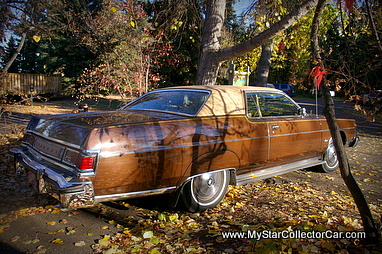
The other day I saw a set of wheels from a bygone Jurassic Car era.
Cars used to be large and in charge in the old days, in fact they were bigger than most pickup trucks in days of yore.
Cars came in three sizes: compact, intermediate and comes-with-a-tug-boat to park it.
These days the big trucks are the kings of the road and many new trucks even outweigh the biggest of old car beasts. But there was a time when dinosaurs ruled the highways and they were giant cars with names like Cadillac, Lincoln and Imperial.
Sure you can still find a Lincoln or Caddy badge on today’s giants, but they are now trucks. When exactly did the big cars fade to black in the automotive scene? Actually It was a slow process that started long before WWII and ended in the 21st century with the Ford Crown Vickies.

The golden era of the big cars was the late 50s and 60s when large and in charge was the order of the day. People measured their status by the Cadillac scale which defined the status of wealthy old guys and successful criminals. Throw in an Elvis or two and you get the picture: big Caddy equals the picture of wealth and success on the Cadillac scale.

Greedy and successful TV banker Milburn Drysdale owned an Imperial to define his success. He used a chauffeur to drive him around in his Impy and the combination did not seem like an exaggeration at the time. In fact we did a real life story about an actual banker-owned Imperial from the Drysdale era and apparently this banker did have a driver for his car.

Eventually we reached the 70s and the era of the giant car was nearing its sunset years. High gas prices and a dwindling market for the big iron were realities in the Me Decade. The new consumer was a younger driver in a smaller car in the 70s.
“Smaller car” was a very relative term in the 70s because the new consumer still chose big cars with long hoods and short decks. It is a fact the new smaller car choices in the 70s were still bigger than most of the reasons not to attend a Sister Sledge concert in the 70s and these cars would be giants on today’s roads.

The choice of the younger car buyers was sportier two door hardtops that still had acres of sheet metal and really cramped rear seats that would severely challenge a first string Cirque Du Soleil performer for difficulty of entry and exit.

The age of the really giant car began to wind down in the 80s and eventually Cadillac was one of the last holdouts in this department. The Caddy held on to its classic 70s large-barge look until well into the 80s, presumably until they lost their niche market of old guys who leave the blinkers on head to the big freeway in the sky-still driving 10-20 under the speed limit the whole way.

Despite that stereotype, I still like to see these big boys from Detroit’s past at the car shows.
They remind me of a time when big car dreams were the stuff of songs and legend.
Jim Sutherland

























































